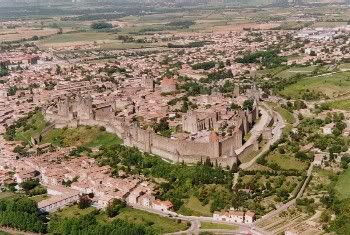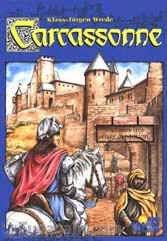From the official Carcassonne site :
“The Walled City of Carcassonne is known first and foremost as a fortified medieval town; but this rocky outcrop has been occupied by man since the 6th century B.C., first as a Gaul settlement, then as a Roman town fitted with ramparts as early as the 3rd and 4th centuries A.D.”
A couple of other interesting sites on Carcassonne are found here: http://www.carcassonne.culture.fr/ and http://www.carcassonneinfo.com/ .

In Klaus-Jurgen Wrede’s game named after the city, players assemble an overhead faux map of Carcassonne by laying tiles adjacent to each other in an ever-expanding landscape. Players complete walled castles, enclose cloisters and terminate roads, and claim these by placing their followers, in order to score points.
It’s not exactly clear what role the players take in the game. Are they gods, looking down upon a blank slate and painting it like brush upon canvas? That’s a possibility. The followers may represent the gods’ Avatars who are sent to earth as pawns in their little game. This is all speculation of course.
The game is produced by Hans im Gluck, and thus carries the company’s high production values. The tiles are linen-finished and are thick and weighty. The colorful wooden followers might be called “cute”, and have become a mascot for German games fans. A rather convoluted small scoreboard is included. It’s got a winding road design, which is nice thematically, but somewhat hard to use. Players can dispense with it and just keep score with pen and paper – you’ll need a lot of table space to play Carcassonne. All this comes in a too-large box, which is nice in a way because HiG has released a horde of expansions for the game. You can toss the plain cardboard insert and keep a few expansions with the base game in the original box. The later editions of the base Carcassonne include one of the aforementioned expansions, The River, which we will not discuss here.
Carcassonne is remarkable for winning both the Spiel des Jahres (unsurprising) and the Deutscher Spiele Preis (surprising) awards in 2001. Carcassonne is a pretty good game for the family, but it’s not in the weight class of the usual strategy games that the DSP honors.

The Game
Each of the Carcassonne game tiles bears a part of a castle, a segment of road, an open field or a cloister. Some contain more than one element. All of these tiles are turn face-down and are mixed up into a common draw pile (or they can be dumped into a cloth bag, bag not included with the game). A marked starting tile is placed in the center of a spacious playing area. On his turn, each player will draw a tile from the bag and place it on the table, connecting it to a previously-played tile. The only restriction is that any of the edges of the new tile being placed must bear terrain that matches that of any tiles it becomes connected to. This is the nice part of the game’s design. The tiles seem to fit together nicely and form a pretty picture despite the jigsaw puzzle nature of the game.
Once the player has placed his tile, he now has the option of placing a follower on the just-played tile. He needs to place the little wooden fellow to clearly claim either a road, a castle, a cloister or an open field. Once the follower has been placed, he takes up a profession as a brigand, a knight, a monk or a farmer, and remains on the tile until the particular terrain is scored or the game ends. If a castle is completed (i.e., it is enclosed on all sides by walls), the player with the most knights within the castle scores. If a road is completed by terminating its two ends in villages or buildings, the brigand on that road scores. If a cloister is enclosed on all sides, the monk within that cloister scores. Farmers only score at the end of the game, and they score for each castle within their field. Fields are defined by roads and buildings around them. It is possible for more than one farmer to supply a particular castle, in which case the player with more farmers supplying that particular castle scores. Once a follower scores for his player, that follower is taken off the map and returned to the player’s reserve.
Scoring in the course of the game is important because each player has a finite supply of followers. If all of a player’s followers are deployed on the map, then he is unable to create any more scoring opportunities until one of his pending projects is completed and scored.
Once all of the tiles have been placed, the game ends. Uncompleted projects are scored, albeit at a reduced value compared to the scoring for completed projects. The player with the most points at the end of the game wins.
Strategy
Most games of Carcassonne are simple, straightforward affairs. Players play tiles, place their followers, then try to complete their own projects. This is the sort of play expected when with non-gamer friends or family. It can even be approached as a cooperative activity, with each player receiving advice from the others on what the best play for a tile is. When the map is completed, the group can ooh and aah over the nice landscape.
Carcassonne can also be played more competitively, with players placing followers in cities or roads already occupied by other players’ followers in an attempt to steal the score for those terrains. An even more competitive maneuver is to place tiles such that a particular terrain (especially castles) cannot be completed due to the absence of a tile that can fit the resulting space that needs to be closed off to score. A similar approach can be made with opposing farmers. The field occupied by the farmer can be shrunk by building a road around the fellow, severely restricting the castles that the farmer can supply.
The problem with all of this is that the tile draw of Carcassonne is completely random, so players have no way to further any plans they make if they are unable to get any useful tiles.
Reviewer’s Tilt
Carcassonne is a light, random game where the luck of the tile draw determines who wins in most cases. This becomes even more pronounced when playing with three or more players, as the state of the map can change dramatically between a player’s turns. There is a distinct feeling of lack of any kind of control, particularly when a player is drawing nothing but road tiles for several turns.
As such, it is a decent introductory game for people new to German games, but it can be outgrown quickly as dissatisfaction with the tile draw can alienate players. The repetitiveness of the game can also quickly become extremely boring. Adding some expansions into the mix might alleviate some of the tedium, but at heart it’s still the same game mechanism with the same amount of luck.
The game is certainly worth experiencing once or twice, just to see the completed map at game end and to say that you’ve played with the cute little wooden followers. However, once players have been introduced to other more advanced and varied German games, it would not be surprising for Carcassonne to be left on the shelf for very long stretches of time.
No comments:
Post a Comment